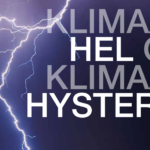7-9-2010; 11.16u – Kop en intro aangepast op basis van alle reacties.
Met het 1-op-1 overnemen van de term “plagiaat” uit de kop van het blogbericht van Donna Laframboise van 3 september The book the IPCC plagiarised is een heftige discussie losgetrapt op deze website. Dank voor ieders bijdragen. Uiteindelijk zie ik me genoopt de titel aan te passen. Het laat onverlet dat Laframboise overtuigend laat zien dat het beeld dat het IPCC ooit zuiver wetenschappelijk begon en pas de laatste jaren politiek gecorrumpeerd raakte, moet worden bijgesteld.
Laframboise ontdekte dat de Australische IPCC-auteur Tony McMichael heeft in de klimaatbijbel 2.0 die in 1995 verscheen vele passages uit zijn eigen apocalyptische activistische boek Planetary Overload uit 1993 parafraseerde. Dit boek putte weer vrijelijk uit de eeuwige Greenpeace folders. Niet netjes is dat het boek niet wordt genoemd tussen de 182 referenties van het hoofdstuk over klimaat & gezondheid.
Voor het hele verhaal zie The book the IPCC plagiarised. Voor het gemak wel hieronder de complete reeks gevonden geparafraseerde passages. Vermakelijke lectuur:
McMichael’s 1993 book, page 150:
Sandstorms in Kansas (USA) and in the Sudan have been accompanied by increased illness and death from bronchitis and asthma.
Climate Bible’s 1995 Working Group 2 report, page 578:
Sandstorms in Kansas (USA) and the Sudan have been accompanied by increases in bronchitis and asthma.
.
McMichael’s 1993 book, page 155:
In Egypt, for example, the water snails tend to lose their schistosome infections during the winter months (January-March). However, if temperatures increase, snails may spread schistosomiasis throughout the year, thus increasing the already heavy parasite burden in rural Egypt.
Climate Bible’s 1995 Working Group 2 report, page 574:
In Egypt, for example, water snails tend to lose their schistosome infections during winter, but if temperatures increase, snails may mediate schistosomiasis transmission throughout the year.
.
McMichael’s 1993 book, page 155:
Arboviral infections span a wide clinical spectrum, from those that cause mild feverish illness or subclinical infections to those causing severe and often fatal encephalitis (brain inflammation) or hemorrhagic fever. Under favourable environmental conditions, an arboviral disease can become epidemic (population-wide), from a local endemic base – in much the same way that cholera has recently broken out…
Climate Bible’s 1995 Working Group 2 report, page 575:
Arboviral infections span a wide clinical spectrum, from those that cause mild feverish illness or subclinical inflections to those causing severe and often fatal encephalitis (brain inflammation) or hemorrhagic fever. Under favorable environmental conditions, an arboviral disease can become epidemic (population-wide), from a local endemic base or by its introduction to a previously unaffected area.
.
McMichael’s 1993 book, page 154:
In eastern Africa, a relatively small increase in winter temperature would enable the malarial zone to extend ‘upwards’ to engulf the large urban highland populations that are currently off-limits to the mosquito because of the cooler temperatures at higher altitudes – e.g. Nairobi (Kenya) and Harare (Zimbabwe). Indeed, such populations around the world, currently just outside the margins of endemic malaria, would provide early evidence of climate-related shifts in the distribution of this disease.
Climate Bible’s 1995 Working Group 2 report, page 574:
Hence, it is a reasonable prediction that, in eastern Africa, a relatively small increase in winter temperature could extend the mosquito habitat and thus enable faciparum malaria to reach beyond the usual altitude limit of around 2,500 m to the large, malaria-free, urban highland populations, e.g. Nairobi in Kenya and Harare in Zimbabwe. Indeed, the monitoring of such populations around the world, currently just beyond the boundaries of stable endemic malaria, could provide early evidence of climate-related shifts in malaria distribution.
.
McMichael’s 1993 book, page 165:
Already in Africa, there are over 100 million people who are ‘food insecure’, many of them in the arid Sahel region, home to approximately 35 million people.
Climate Bible’s 1995 Working Group 2 report, page 577:
Already in Africa, more than 100 million people are “food insecure,” many of them in the arid Sahel region.
.
McMichael’s 1993 book, page 166:
A rise in temperature could also have significant effects on the growth and health of farm animals. Young animals are less tolerant of a wide range of temperature than are adult animals.
Climate Bible’s 1995 Working Group 2 report, page 577
An increase in temperature and temperature extremes could also affect the growth and health of farm animals; young animals are much less tolerant of temperature variation than are adult animals.
.
McMichael’s 1993 book, page 166:
With respect to adverse effects on livestock, the U.S. Environmental Protection Agency has identified several infectious diseases – such as the horn fly in beef and dairy cattle and insect-borne anaplasmosis infection in sheep and cattle – which might well increase in response to climate changes.
Climate Bible’s 1995 Working Group 2 report, page 577:
For example, the U.S. Environmental Protection Agency has identified several infectious diseases – such as the horn fly in beef and dairy cattle and insect-borne anaplasmosis infection in sheep and cattle – that could increase in prevalence in response to climate changes.
.
McMichael’s 1993 book, page 187:
UNEP predicts that an average 10% loss of ozone (such has become established at middle-to-high latitudes in recent years), if sustained globally over three-four decades, would cause at least 300,000 additional cases of non-melanocytic skin cancer worldwide each year and 4,500 extra cases of malignant melanoma – and possibly double that figure.
Climate Bible’s 1995 Working Group 2 report, page 578:
The UN environment Programme predicts that an average 10% loss of ozone (such as occurred at middle-to-high latitudes over the past decade), if sustained globally over several decades, would cause approximately 250,000 additional cases of [nonmelanocytic skin cancers] worldwide each year.







@Paul van Egmond
Aha. En waar beschuldig je McMichael dan nu precies nog van?
Op z'n minst van onprofessioneel gedrag. En dat is een stuk minder dan waar ik jou van beschuldig.
Paul van Egmond schrijft: “Nu zijn er onderzoeken gedaan naar CRU, Mann en het IPCC en geen van deze onderzoeken was vernietigend (hoewel ik me afvraag of Pachauri kan aanblijven). Maar wie roept de deniers ter verantwoording?”
Beste Paul,
Op het eerste deel van bovenstaande heeft Hans Erren al geantwoord met zijn omgekeerde Barbertje. Dan nu jouw vraag. Er zullen ongetwijfeld “deniers” (wat dat ook mogen wezen) zijn die “bullshit” produceren. Maar waarvoor dient men ze ter verantwoording te roepen? Voor El Niño?
@Hans Erren: tja, het is een valide keuze om geen van de onderzoeken te vertrouwen. Maar het is niet mijn keuze. Als je na een bezoek aan je specialist een second opinion wilt, waar ga je dan naartoe? Naar Jomanda of toch maar naar een andere dokter?
@De Woedende Kok: och, misschien voor het volledig beschuldigen van plagiaat door McMichael (Laframboise)? Of voor het opkloppen van het Nederlandse zeeniveaufoutje (link) in het IPCC-rapport? Voor het steeds weer theoretische oude koeien uit de sloot halen die allang zijn weerlegd of gedebunked (link)? Voor het vervalsen van grafieken (link? Of wellicht voor het poneren van halve waarheden en hele leugens (zie alles van Monckton) om zowel het IPCC als individuele wetenschappers zo veel mogelijk dwars te zitten (<a>link?
@T2000: McMichael kwam op basis van zijn uitgebreide ervaring en publicaties tot een aantal conclusies, die hij vervolgens twee keer opschreef. Hoe je daaruit opmaakt dat hij zich onprofessioneel zou hebben opgesteld is me echt een raadsel. En waar beschuldig je mij dan precies van? Van op de man spelen? Komkom, een grote jongen als jij kan toch wel tegen een sneertje of 2?
Paul, je vraag over die second opinion was niet aan mij gericht maar ik snap hem niet. Als mij wat ernstigs mankeert dan ga ik naar een dokter/expert en als het advies of de diagnose mij niet bevalt dan vraag ik een second opinion bij een andere arts (of aan Jomanda).
Ik neem zelf de stap naar die eerste deskundige en de uiteindelijke beslissing neem ik ook zelf.
Je slaat trouwens denk ik de spijker op de kop als je zegt: McMichael kwam op basis van zijn uitgebreide ervaring en publicaties tot een aantal conclusies. Dat is juist het opmerkelijke, activist/politiek opportune McMichaels beperkt zich in het IPCC rapport uit de ontelbaar mogelijke citaten tot zijn eigen, niet onderbouwde, conclusies.
Paul van Egmond,
De dingen die je noemt staan echt nog wel voor een flink deel ter discussie. Bovendien nou niet bepaald zaken die er toe hebben geleid dat de samenleving miljarden uitgeeft aan maatregelen die nergens goed voor zijn. Het feit dat wij vanuit de groen-warme hoek al decennia lang worden bestookt met o.a. de CO2-ondergangsmythe kost ons dagelijks veel geld dat beter ingezet kan worden voor het oplossen van problemen hier en nu.
Van mij mag Vendrik op de kermis gaan staan met een kaasstolp, een flesje CO2 en een thermometer. Daarvoor kan je iemand niet ter verantwoording roepen. Wel voor het feit dat er op basis van dit soort “wetenschap” geld over de balk wordt gegooid.
"och, misschien voor het volledig beschuldigen van plagiaat door McMichael (Laframboise)?"
Ach, het beschuldigen van plagiaat komt ook in warmere kringen voor, zie Taminio's beschuldigingen aan het adres van Wegman. Grappig, maar verder totaal onbelangrijk in deze hele discussie.
Opkloppen? Theoretische oude foutjes? Dit is wel heel erg badinerend.
Jij troeft met Monckton, ik ga er overeen met mijn aas Al Gore…
Ik zie dat ik het woord 'onterecht' was vergeten in de zin "och, misschien voor het volledig beschuldigen van plagiaat door McMichael (Laframboise)?"
@Woedende Kok: 'die dingen' staan alleen nog maar ter discussie omdat anti-AGW-adepten er maar niet over ophouden en reeds aangetoonde debunks ten enen male negeren.
@Harold: mijn punt is dat, wanneer je als niet-expert wilt weten of een expert zijn werk goed doet, je je zult moeten verlaten op een andere expert. Je loopt dan de kans dat ze samen onder een hoedje spelen en daar zul je als klant/patiënt/opdrachtgever dan dus beducht op moeten zijn. Het feit is dat de onderzoeken naar CRU etc. zijn uitgevoerd door wetenschappers en hun resultaten zijn geaccepteerd door de politiek. Je kunt het hele zaakje dan wel blijven wantrouwen maar als er elke keer weer geen bewijs van kwade opzet wordt gevonden, moet je rekening houden met de mogelijkheid dat die kwade opzet er ook niet was.
Hoe kom je er trouwens bij dat de conclusies van McMichaels niet onderbouwd zijn? Dat jij je er niet in kan vinden is niet hetzelfde dan dat hij zomaar wat opschrijft.
@TINSTAAFL: Het verschil is dat de beschuldiging van plagiaat door McMichael niet klopt. Van het Wegman rapport klopt de beschuldiging van plagiaat wel. (link).
Lever die aas maar in. Schoppenboer Al Gore heeft zich enigszins vertild in zijn klimaatpresentaties. Maar waar hij de zaken soms opklopt en in sommige gevallen urgenter voorstelt dan ze zijn, komt Monckton met pertinente leugens.
"@TINSTAAFL: Het verschil is dat de beschuldiging van plagiaat door McMichael niet klopt. Van het Wegman rapport klopt de beschuldiging van plagiaat wel. (link)."
Klopt dus niet. Zoals bekend beschuldigde Tamino in zijn blog Wegman in verband met Rapp. Tamino heeft, evenals Hajo, deze bschuldiging moeten terugnemen (zie zijn update op dezelfde pagina).
De link die jij opvoert is eveneens geen enkel bewijs van plagiaat, maar slechts een zwakke poging zijn gezicht te redden.
Ik denk dat je Gore onderschat:
Gore : Nobel Prize (met buddy Pachauri), $300.000 vergoeding per speech, aangevlogen in een private jet.
Monckton : dubieuze titel, $20.000 per speech, lijnvlucht.
Overigens heb ik beide niet hoog zitten.
Ik ben het zeker met Paul van Egmond eens.
Sommige van de andere reacties zijn op kleuterniveau… Het meest bizar is wel dat men meent dat een ANDER (mogelijk) geval van plagiaat rechtvaardigt om McMichael van plagiaat te gaan beschuldigen. Wat is dit voor stupide redenering? Mag ik mijn buurman slaan omdat zijn achter-achterneef in de VS misschien een buurman geslagen zou hebben?
En lezen jullie het hoofdstuk überhaupt? Zie je dan de bronvermeldingen en referenties niet staan?
McMichael en zijn mede-auteurs "citeren" niet. De 29 pagina's van het hoofdstuk zijn een assessment van de meer dan 500 wetenschappelijke publicaties vermeld in de referenties aan het eind van dit hoofdstuk. De onderbouwing staat EXACT in de bronnen, waarnaar in IEDERE paragraaf verwezen wordt.
McMichael en andere (lead) authors dienen de wetenschappelijke informatie over de mogelijke gevolgen van klimaatverandering te beoordelen ('to assess'). En in hun specifieke hoofdstuk van WGII gaat het over de mogelijke gevolgen ('potential impact') voor "Human Population Health”.
Hun taak is de bestaande literatuur op dit gebied te beoordelen, niet om hier zelf onderzoek te doen.
Het is een proces van zoeken naar de relevante wetenschappelijke literatuur en naar overige informatie, de informatie clusteren op onderwerp, toetsen op kwaliteit, de overeenkomsten en verschillen in kaart brengen… en dan in onderling overleg de conclusies daaruit destilleren en met een bepaalde graad van zekerheid ('possibly/likely/highly likely') deze eenduidig op papier zetten. Bij élke conclusie dient vermeld te worden op welke wetenschappelijke publicaties deze berusten.
Vandaar het grote belang van de precieze BRONVERMELDINGEN in de tekst zelf, en de referenties aan het eind (waar je elk van de bronnen terug kan vinden). Dit moeten de primaire wetenschappelijke bronnen zijn, niet eventuele andere summaries of populair-wetenschappelijke boeken, bijvoorbeeld van de (lead) authors.
Je hebt dus minstens twee 'lagen':
1 – de wetenschappelijke bronliteratuur (de grondslag).
2 – het 'assessment', de samenvatting en de conclusies (naar beste beoordelingsvermogen) door de IPCC auteurs.
Essentieel is dat de hypothesen, het onderzoek, het vrije debat, de empirische toetsing, de falsificering en alle NIET-CONSENSUS zich vrijuit in laag 1 (de eigenlijke wetenschap) kan afspelen. Laag 2 (de IPCC rapporten) zijn alleen een 'assessment' – men steekt de thermometer er in en maakt een momentopname van de huidige stand van de wetenschap.
Kijk 's woord-voor-woord naar het officiële document “PRINCIPLES GOVERNING IPCC WORK”:
Tot slot nog even over academische vrijheid, en 'freedom of speech' in het algemeen.
Uiteraard mag een wetenschapper zijn meningen, hypothesen of conclusies meerdere keren onder woorden brengen en opschrijven. Alléén als hij het werk van een ander citeert of parafraseert, moet hij de bron vermelden. Onder die conditie mag je vrijuit andere wetenschappelijke publicaties citeren.
Als een wetenschapper niet meer het RECHT zou hebben op zijn eigen woorden en meningen, dan zou het de totale doodsklap zijn voor alle wetenschapsbeoefening en voor vrijheid van meningsuiting in het algemeen.
Deze rechten kunnen alleen iets ingeperkt worden door het auteursrecht op een werk te verkopen aan een uitgever of aan een journal. Zelfs dan mag je (in redelijkheid) dezelfde woorden kiezen. In dit specifieke geval is McMichael nog eens extra netjes geweest door in zijn populair-wetenschappelijke boek de paar overeenkomstige zinsneden te parafraseren! En dat terwijl de rechten van beide bij dezelfde uitgever berusten…
Het is dus nóg plagiaat, nóg schending van het auteursrecht.
End of story. :)
Amen. Dit topic heeft zich lang genoeg voortgesleept. Laten we in een ander topic ruzie gaan maken :-)
“PRINCIPLES GOVERNING IPCC WORK”
Het lijkt wat droef om die er bij te betrekken nu men zich daar niet volledig aan heeft gehouden.
Schellekens wordt geciteerd:
"..
Fondsen worden steeds meer opgehangen aan een bepaald doel. Onderzoek moet bij voorkeur een voorspelbare uitkomst hebben en een bijdrage leveren aan de kenniseconomie.
.."
http://noorderlicht.vpro.nl/artikelen/43916153/
Daarmee wordt (voor mij) duidelijker dat het IPCC wel voort *moest* borduren op eerdere WG1 bevindingen met een code oranje label.
En aldus de andere WG's de kans lieten om daar code rood van te maken.
"Sommige van de andere reacties zijn op kleuterniveau… Het meest bizar is wel dat men meent dat een ANDER (mogelijk) geval van plagiaat rechtvaardigt om McMichael van plagiaat te gaan beschuldigen. Wat is dit voor stupide redenering? Mag ik mijn buurman slaan omdat zijn achter-achterneef in de VS misschien een buurman geslagen zou hebben?"
Deze metafoor slaat echt als een tang op een varken en een rechtvaardiging heb ik ook nergens gegeven (een citaat hiervan a.u.b.?). De juiste metafoor zou hier overigens zijn "De Pot verwijt de Ketel dat hij zwart ziet".
Nogmaals, Spaanse Bob's berichten zijn alleen maar rookgordijnen om te verhullen dat IPCC een consequent (politiek) beleid heeft de AGW theorie wetenschappelijk te ondersteunen en te advocateren.
Ik zat vanmiddag op de rand van het bed mijn tanden te poetsen en tipte de tv aan in de hoop dat die twee minuten niet geheel in ledigheid zouden wegtikken. Kijk ik recht in de bebaarde scheur van Neerlands goeiste operettezanger “weet-ik-veel”. Het programma heet: Van popzanger tot operaster. Zoekt u maar even op. Het fijne weet ik er niet van, maar “het format” laat zich raden: Derderangs liedjeszanger zingt stukje opera en wordt beoordeeld door derderangs operaster. Daar gaan ze nog jaaaaaaren lol aan gaan beleven.
Ik pikte nog net de laatste maten mee van Wolter Kroes’ uitvoering va n Verdi’s La donna è mobile. Wolter was een beetje uit z’n doen en volgens mij dacht ie dat hij zojuist de Italiaanse versie van ‘baby you can drive mij car’ ten gehore had gebracht.
De presentator onderbrak de vrolijkheid omdat hij het even met ons over een ernstige aangelegenheid wilde hebben. Dat zat zo, hij was voor NOVIB naar “de steeds meer genadeloos oprukkende Sahel” geweest. En daar wordt het ieder jaar droger en droger. Geen bomen meer, niets meer te verbouwen. En dat komt dus door de klimaatverandering.
Niet duidelijk werd of het nu over de hele Sahel ging en over alle gewassen of …….. enfin u kent de kwestie.
Nou vraag ik Paul van Egmond af: Hoe weet die zingende baard dat toch allemaal?
P.s. Wil je het nog gekker? Ik krijg zojuist een uitnodiging: “Workshop Foodprint Cooking – Horeca werkt mee aan ecologische foodprint” bij dezelfde groothandel waar je van die peperdure klimaatneutrale koekenpannen kon kopen (na een maand helaas alweer uit het assortiment).
“Schiet mij maar lek!” om met Wolter te spreken. Nog effe en het is IPCC voor al uw feesten en partijen.
Tja, als we ook al onzorgvuldigheden bij ontbijt-tv moeten gaan debunken, blijven we bezig.
Overigens zou zo'n foodprint-workshop best eens heel aardig kunnen uitpakken. Ik ben zelf wel gevoelig voor het concept 'voedselkilometers': een indicatie van de afstand die het voedsel over deze aardkloot aflegt voordat het sissend in de pan belandt. Of gutst in je glas. Zo verbaas ik mij als niet-kenner over het ruime assortiment supermarktwijntjes uit Californië, Zuid-Afrika en Australië tegen zeer schappelijke prijzen. Wijn uit Spanje, Duitsland, Frankrijk en Italië is toch ook prima te drinken? Moet dat nou per se de halve wereld over worden getransporteerd?
Ander bekend voorbeeld: Noordzeegarnalen worden gepeld in Marokko, Dieren worden heel Europa doorgesjeesd om er Parmaham of Scharzwalderschinken van te maken (slacht je ze buiten het gebied, dan mag die naam er niet op) en zo zullen er nog wel meer voorbeelden zijn waarbij je denkt van 'huh'?
Paul van Egmond,
Hoe het werkt: De zanger praat het NOVIB na, die het IPCC napraat, die produceert wat door politiek wordt gedicteerd onder druk van milieu-NGO’s. “De in opera geïnteresseerde” televisiekijker (die ook een stukje pop wel kan waarderen) verneemt bij monde van de operazanger over “de steeds meer genadeloos oprukkende Sahel” en herinnert zich het betoog van de niet meer nader bij naam te noemen hooggeleerde Saabrijder uit Wageningen. Aldus kruipen veel kappersbedienden, stratenmakers en koks na een lange werkdag onder de wol met het idee dat het wel zo wezen zal. Zo worden wij dus getrakteerd op een voortdurend schouwspel met operette-alarmisten van alle niveaus in de hoofdrol.
Opiniemarketing noem ik dat en het lijkt verdacht veel op de brand-marketing van de Italiaanse hamboeren die door roeien en ruiten zijn gegaan om hun product te beschermen.
De betreffende horecagroothandel zal onze carbon footprint “van met Nederlands waterig varkensvlees gemaakte chorizo” wezen. Net als de operazanger is hij doende zijn imago op te poetsen. Hun goedheid doet je haast pijn aan de ogen.
Het pellen van garnalen in Marokko is het gevolg van hygiënewetgeving en productiekosten. De verwachting is dat de moderne pelmachines in Lauwersoog steeds meer van de Marokkaanse productie zullen overnemen.
Nuance en televisie gaan nu eenmaal slecht samen.
Rukt de Sahel op? Ja. Heeft dat te maken met veranderende neerslagpatronen? Ja, deels. Het heeft ook te maken met de steeds grotere druk die de bevolking aldaar legt op de resterende natural resources. Hoe veel aan welke oorzaak is toe te schrijven? Geen idee. Ik weet niet welke bewoordingen deze zanger (Ernst Daniel Smid(t?)) precies heeft gebruikt maar de uitspraak "De oprukkende Sahel komt deels door het veranderende klimaat" lijkt me meer juist dan de uitspraak "De oprukkende Sahel heeft niets met klimaatverandering te maken". Maar ik vermoed dat hij niet 'deels' (of 'gedeeltelijk' of 'mede') heeft gezegd en dat is jammer.
http://climategate.nl/2010/03/10/leven-op-de-rand…
Rukt de Sahel op?
http://www.klimatosoof.nl/
http://oceanworld.tamu.edu/resources/environment-…
en
http://www.telegraaf.nl/buitenland/7413201/__Acti…
Al moet ik zeggen: de stijgende agrarische output van Niger die wordt aangehaald op klimatosoof.nl is indrukwekkend. Laten de buurlanden een zelfde stijgende trend zien?
De grafiek op pagina 19 van dit <a href="http://docs.google.com/viewer?a=v&q=cache:9uRENKF4yd0J :www.unep.org/Themes/Freshwater/Documents/pdf/ClimateChangeSahelCombine.pdf+desertification+sahel&hl=en&pid=bl&srcid=ADGEEShSSahuykzUPLi3o8YntscfV4vMmdAtYOZTMJrRdTNgf38kDA6dntamUhYDq9DySCgDLB9nykzIpDXsXom98PCBVraf3By22zlsdVAEWoscaExlyqhF-Gll5f_kwf97BC8eyDnJ&sig=AHIEtbReiq3zMWQ-IQRl8dPH5QheHVxK4w" rel="nofollow"> UNEP-rapport gaat maar tot 1994 maar laat wel een dalende trend in neerslag zien. Op http://jisao.washington.edu/data/sahel/ kom ik een grafiek tegen waaruit blijkt dat de neerslagtrend de laatste jaren lijkt om te buigen; het tekort tov het langjarig gemiddelde wordt kleiner (maar bestaat nog wel).
@TINSTAAFL
Het was niet Tamino, maar Deep Climate (of is Tamino ook Deep Climate? Lijkt me niet, DC heeft iets meer geduld met zijn commenters ;-) ).
Inmiddels is er weer meer informatie.
This is a good blog. Carry on everything. I very adore blogging and site-building and also making our opinions. Thank you :)